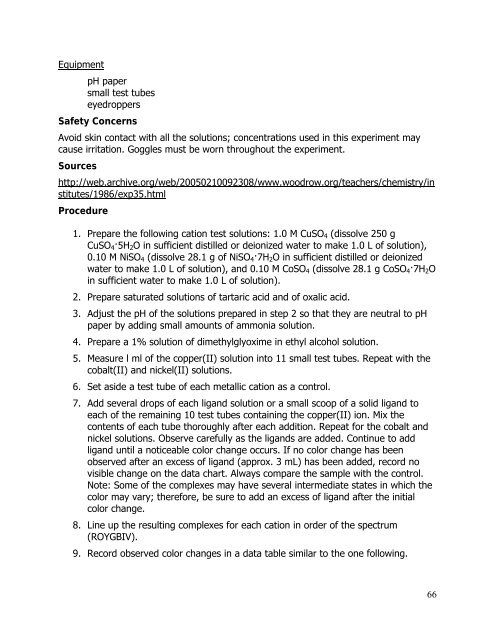Electrons and Quantum Mechanics - Oakland Schools
Electrons and Quantum Mechanics - Oakland Schools
Electrons and Quantum Mechanics - Oakland Schools
You also want an ePaper? Increase the reach of your titles
YUMPU automatically turns print PDFs into web optimized ePapers that Google loves.
Equipment<br />
pH paper<br />
small test tubes<br />
eyedroppers<br />
Safety Concerns<br />
Avoid skin contact with all the solutions; concentrations used in this experiment may<br />
cause irritation. Goggles must be worn throughout the experiment.<br />
Sources<br />
http://web.archive.org/web/20050210092308/www.woodrow.org/teachers/chemistry/in<br />
stitutes/1986/exp35.html<br />
Procedure<br />
1. Prepare the following cation test solutions: 1.0 M CuSO 4 (dissolve 250 g<br />
CuSO 4·5H 2 O in sufficient distilled or deionized water to make 1.0 L of solution),<br />
0.10 M NiSO 4 (dissolve 28.1 g of NiSO 4·7H 2 O in sufficient distilled or deionized<br />
water to make 1.0 L of solution), <strong>and</strong> 0.10 M CoSO 4 (dissolve 28.1 g CoSO 4·7H 2 O<br />
in sufficient water to make 1.0 L of solution).<br />
2. Prepare saturated solutions of tartaric acid <strong>and</strong> of oxalic acid.<br />
3. Adjust the pH of the solutions prepared in step 2 so that they are neutral to pH<br />
paper by adding small amounts of ammonia solution.<br />
4. Prepare a 1% solution of dimethylglyoxime in ethyl alcohol solution.<br />
5. Measure l ml of the copper(II) solution into 11 small test tubes. Repeat with the<br />
cobalt(II) <strong>and</strong> nickel(II) solutions.<br />
6. Set aside a test tube of each metallic cation as a control.<br />
7. Add several drops of each lig<strong>and</strong> solution or a small scoop of a solid lig<strong>and</strong> to<br />
each of the remaining 10 test tubes containing the copper(II) ion. Mix the<br />
contents of each tube thoroughly after each addition. Repeat for the cobalt <strong>and</strong><br />
nickel solutions. Observe carefully as the lig<strong>and</strong>s are added. Continue to add<br />
lig<strong>and</strong> until a noticeable color change occurs. If no color change has been<br />
observed after an excess of lig<strong>and</strong> (approx. 3 mL) has been added, record no<br />
visible change on the data chart. Always compare the sample with the control.<br />
Note: Some of the complexes may have several intermediate states in which the<br />
color may vary; therefore, be sure to add an excess of lig<strong>and</strong> after the initial<br />
color change.<br />
8. Line up the resulting complexes for each cation in order of the spectrum<br />
(ROYGBIV).<br />
9. Record observed color changes in a data table similar to the one following.<br />
66
















